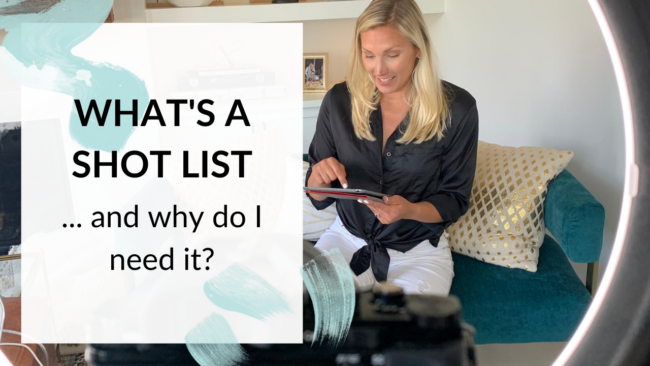Save money and valuable time with a photoshoot shot list
A shot list is a critical part of any photoshoot — be it for social content, product shots for your site, lifestyle imagery, or any other visual campaign. A shot list outlines the who, what, where, when, and why of your shoot to keep you on track with your time and budget.
If you forego the shot list, you’ll end up getting back to the office with photos that don’t fit where you need them, aren’t aligned, are all the same — or worse, missing altogether.
Here’s our quick breakdown of how to nail a shot list, save yourself time during shooting, and getting the most images you can use out of each photoshoot.
Don’t feel like reading? Watch the video!
Highlight your business goals
Marketing rule numero uno: always, always, always understand why you’re doing each initiative. Go into your photoshoot with your goals not just in mind, but written down too. Make sure they’re clearly communicated to the whole team so the vision is clear, questions are asked, and you’re all fighting the same battle.
Two questions will help you identify those goals. One: Where will these photos be placed? Two: What actions do you want people to take when they see them?
Refer to your content calendar
Your content calendar can help you guide your shots. Take stock of upcoming dates of importance, product launches, and the pieces of content you’re creating.
Note: Capturing some evergreen shots is always great, too. Don’t shy away from taking a few shots you save for a slow week, generic marketing materials, or times you need a solid, branded image.
Break down your important categories
These are the big categories that will structure the order in which you shoot. Maybe you have a couple of different locations, maybe you have two rounds of models, maybe you need different equipment for the types of shots you need — highlight these time-consuming changes as the overarching pieces.
Break your categories into smaller parts
Break each larger category into smaller sections. If you have a model for one hour, break down which outfits they’ll be wearing when. If you have a bunch of product shots on one background, schedule those together before changing scenery.
The key here is to do the majority of the planning before you arrive into the mayhem of the day.
Think about where images will be used
I can’t tell you how many times I’ve kicked myself for getting too many vertical shots when I needed a horizontal one for a certain blog post or thumbnail. Each digital platform or print material requires different parameters for your images. Here are a few things to consider:
- Orientation — landscape vs. portrait
- Resolution — how high or low quality is best
- Macro vs. micro shots — how zoomed in or zoomed out an image is
- Backgrounds — for website product shots it’s important that you can remove the background
Break down realistic timelines
Now that you have your categories, subcategories, and types of images you need to check off the list, it’s time to build your timeframe. The beginning of a shoot always takes a little longer than you think to get rolling, and the end of a shoot always feels a little frantic.
Don’t do that to yourself. Marking the times along each section is a great way to make sure you’re staying on track and can set priorities if the wheels start to fall off.
Pro tip: like a budget, always inflate your times by 20-30% to allow for human error, wardrobe or equipment malfunctions, and general mishaps.
Note all necessary props
Since you’ve thought meticulously about each shot, you know what will help bring those images to life. Maybe it’s a picnic setup complete with a blanket, wine, cheese, and a bougie picnic basket. Or florals and/or crystals to enhance your product shots. Perhaps it’s accessories that bring your clothing to life.
Whatever it is, make a note for the shot it applies to so you don’t forget in the craziness.
Prepare everything beforehand
Props are great. We love props. They really help tell a brand’s story. However, make sure everything shows up to the shoot camera-ready.
- Sneakers are clean
- Inflatables are blown up
- You’ve tested to make sure new items work
- Clothing is steamed and hung
- Accessories are in baggies and attached to the outfit they go with
This seems obvious, but I can’t tell you how many times I’ve seen accessories be missed, props didn’t work, or clothing looked like it had been pulled out of a dirty laundry basket.
Measure twice and cut once, friend.
Pack an on-set kit
Shit happens. Be a good boy scout and always be prepared. These are the go-tos in our kit:
- scissors
- thread and a needle
- double-sided tape
- safety pins
- baby wipes
- paper towel and soft rags
- Windex
- Tide-To-Go pens
- water bottles
Remember, these are the fun days! Get all of the planning and organization out of the way before you arrive to set. A photoshoot shot list will give you the day-of brain capacity to manage people, products, a timeline, and the budget. And actually enjoy a creative day!
Creative strategy and organization aren’t for everyone, so this all might sound terrifying to you. If so, we’re here to help! Reach out to us for any of your branding and digital marketing needs. Let’s go for a coffee — on us!

